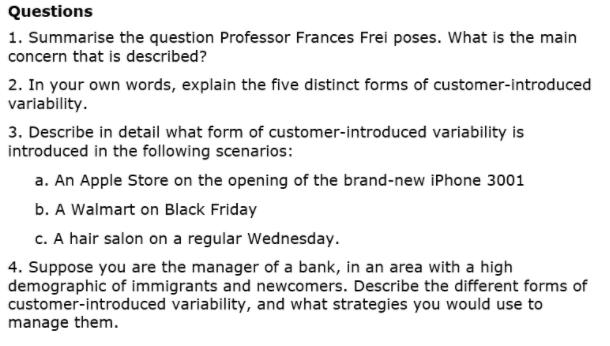CUSTOMER-INTRODUCED same service provider. One customer might want VARIABILITY IN SERVICES a restaurant to make a menu substitution, while another might want the restaurant to serve her af- In her article "Breaking the Trade-off between Efficiency ter closing time. and Service," Professor Frances Frei of the Harvard 3. Capability variability. Some customers are capa- Business School poses an interesting question: ble of performing many service tasks themselves, What if a manufacturer had to deal with cus- while others require substantial hand-holding. tomers waltzing around its shop floor? What 4. Effort variability. Even if they are capable of per- if they showed up, intermittently and unan- forming certain tasks, customers can differ from nounced, and proceeded to muck up the man- one another with regard to the amount of effort ufacturer's carefully designed processes left they are willing to apply to these tasks. For exam- and right? For most service businesses, that's ple, some customers at a grocery checkout will bag business as usual. In a restaurant or a rental their own groceries; others will wait for the cashier car agency or most of the other service compa- or someone else to do it. mies that make up the bulk of mature econo- 5. Subjective preference. Different customers can mies today, customers aren't simply the open perceive the same service outcome differently. wallets at the end of an efficient supply chain. What one customer might interpret as a "quick and They're directly involved in ongoing opera- efficient" answer to a question might strike another tions. The fact that they introduce tremendous customer as a "cold, unsympathetic" response. variability-but complain about any lack of Professor Frei goes on to identify different strategies consistency is an everyday reality." service organizations can use to manage these different In fact, Professor Frei suggests that there are five distinct forms of variability. For example, services can use tar- forms of customer-introduced variability: geted marketing to attract customers with very similar needs and capabilities, thereby reducing request and 1. Arrival variability. Customers arrive when they capability variability. In addition, services can use well- desire service. In some cases, this can be controlled designed automation systems and low-cost labor to take (e-g., a hotel reservation system). In other cases, it over some of the "hand-holding" that might otherwise cannot (e-g., emergency medical services). be done by more expensive skilled labor. 2. Request variability. Customers demand and ex- pect different services outcomes, even from the F. Frei, "Breaking the Trade off between Efficiency and Service," Harvard Business Review 84, no. II (November 1996): 92-101.Questions 1. Summarise the question Professor Frances Frei poses. What is the main concern that is described? 2. In your own words, explain the five distinct forms of customer-introduced variability. 3. Describe in detail what form of customer-introduced variability is introduced in the following scenarios: a. An Apple Store on the opening of the brand-new iphone 3001 b. A Walmart on Black Friday c. A hair salon on a regular Wednesday. 4. Suppose you are the manager of a bank, in an area with a high demographic of immigrants and newcomers. Describe the different forms of customer-introduced variability, and what strategies you would use to manage them








